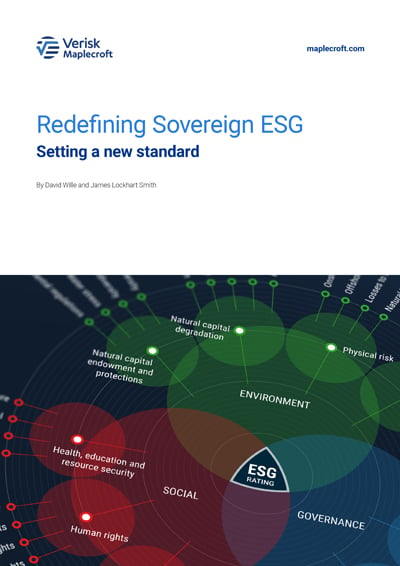4 principles investors should consider when building a sovereign ESG risk framework
Sovereign ESG issue selection must reflect more than recent market materiality
by David Wille,
"What issues go into your sovereign ESG framework and how did you select them?” – this is a common question we hear when discussing our Sovereign ESG Ratings.
Selecting what does (and doesn’t) make it into your final sovereign ESG framework, and justifying why (or why not), are two of the most critical considerations for investors when incorporating ESG factors into sovereign debt risk analysis. But how do you make these decisions? We advocate taking a principled approach.
Getting sovereign ESG issue selection right is crucial
Beyond the clear challenges that sovereign debt investors face in sourcing timely, robust ESG data and effectively incorporating these metrics into investment processes, the issues included in the scope of your assessment will ultimately define both the analytical power and credibility of your model and the results it generates. But nowadays it’s not just investment performance that’s important to your stakeholders. For asset owners, beneficiaries and now regulators too, a complex and often interconnected array of ethical, planetary and ‘values-driven’ materiality concerns are increasingly front of mind as well. This means that when assessing sovereign ESG, government bond investors must now grapple with physical climate and transition risks, the perilous trajectory of global biodiversity and natural capital, and demands to fully apply the UN Guiding Principles on Human Rights, to name just a few of the broad areas.
In this context, selecting issues for an industry-leading sovereign ESG framework is no simple exercise. So, what’s the right way to make these selections?
4 key principles can underpin a powerful ESG incorporation approach
We followed four principles when selecting the ~350 indicators and 37 indices that underpin our Sovereign ESG Ratings framework. We believe (and show) these principles are key to understanding the salience of different ESG issues from a sovereign debt investment perspective:
1. Read the research – materiality matters for sovereign ESG data
Our choice of issues is grounded in a qualitative and principled approach – informed firstly by the findings of relevant academic and industry research, and secondly through feedback and review from a group of our clients who are leaders in sovereign ESG investing. The independent role that ESG plays in sovereign debt markets is well attested by our previous research and others in industry and academia, as is the importance of the governance pillar in particular.
2. Be led by the precautionary principle – anticipate how sovereign ESG materiality will evolve
Critically, the recent market relevance of individual factors cannot be the only selection criterion for a framework which, if it is to endure, must incorporate a precautionary approach to emerging risks. That doesn’t just mean climate change, but any issue where the cost to governments of externalities is changing, or is likely to change, in response to shifting regulations, policies and market preferences. This includes individual human and labour rights. While the recent market materiality of social factors like these has been debated (and since found to be strong), their centrality to the values – and hence requirements – of asset owners and key policymakers cannot.
3. Ethical and planetary ‘values’ judgements are key to the future of sovereign ESG incorporation
We give particular importance to E risk issues in our ESG framework: 17 indices underpin 4 dimensions in the E pillar, which is more than the 12 and 3 respectively in S, and more than the 8 and 2 respectively in G (see Figure 1). We believe our framework will be more useful if it gives a greater role to environmental factors of existential long-term relevance to economies and, to a lesser extent, their social counterparts, over governance factors which are better integrated into traditional credit analysis and are in general – though not always – more efficiently reflected in asset prices.
4. Be disciplined – minimise correlations between ESG metrics (and income)
Finally, we cannot forget the need for a parsimonious model to avoid overfitting and aid interpretability. In choosing indicators, we sought to ensure exhaustive coverage of our nine dimensions, while minimising duplication between indices that are strongly correlated or measure closely related issues. We also excluded any direct measures of income from our framework, with the aim of addressing the long-standing challenge the industry has faced due to the tendency of sovereign ESG scores to be highly correlated with wealth.
The upshot: highly material ratings, scores and (sometimes leading) indicators of sovereign ESG risk
Having followed our four key principles, allied with robust statistical tests, the creation of an appropriately dynamic ratings system, and feedback from leading sovereign debt investors, we found our ESG factors are indeed highly material for market pricing, and in some cases even show a leading indicator relationship.
Of course, it must be said that having the best issue selection process won’t matter without having the best sovereign ESG data to back it up. That’s why our Sovereign ESG Ratings framework is informed exclusively by our world-class Global Risk Analytics Dataset, which encompasses 170+ indices and over 1,200 indicators that draw on an array of geospatial, unstructured, expert-derived and structured sources. Ultimately, it’s the quality of this input data as much as the issue selection principles themselves that make the difference.
Want to learn more about our Sovereign ESG Ratings?
Webinar: Setting a new standard – introducing Verisk Maplecroft's new Sovereign ESG Ratings for investors (09 March at 1500 GMT / 1000 EST, and available on-demand afterwards)
Webinar: ESG risks and opportunities for sovereign debt investors in the Americas region – lessons from our new Ratings (23 March at 1500 GMT / 1100 EDT, and available on-demand afterwards)
Discover our Sovereign ESG Ratings, Insights and the wider Sovereign ESG Intelligence we deliver for investment managers, asset owners, hedge funds, banks and insurers.


